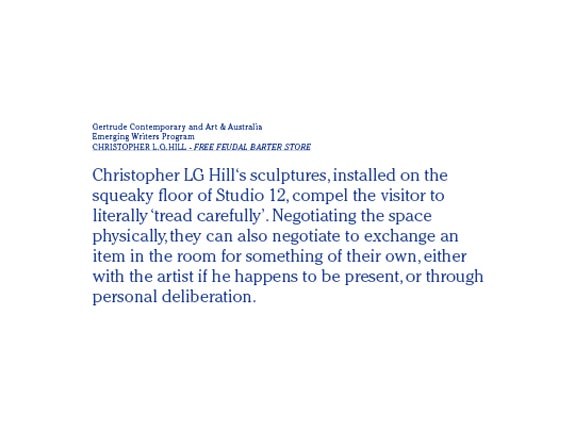programs

EMERGING WRITERS: CHRISTOPHER LG HILL
Download the catalogue here
Christopher LG Hill‘s sculptures, installed on the squeaky floor of Studio 12, compel the visitor to literally ‘tread carefully’. Negotiating the space physically, they can also negotiate to exchange an item in the room for something of their own, either with the artist if he happens to be present,or through personal deliberation.
Hill embraces the sometimes uncomfortable theatricality of the gallery and encourages a heightened awareness of the undercurrent of give and take inherent in daily life.This process calls attention to the underacknowledged fact that many art institutions like Gertrude Contemporary are free to visit, placing no onus on the viewer to provide anything in exchange for experiencing an exhibition. Hill is not aiming for a grand political gesture. His is a subtle activism, anchored in a connection to his community of fellow artists, both in Melbourne and online.
The accumulation of objects in Hill’s sculptures reflect an accumulation of small transmissions which will be the result of Free Feudal Barter Store. Hill’s practice is rooted in the reinterpretation and repurposing of known structures and institutions. In Free Feudal Barter Store, Hill draws on the re-emergence of Free Stores (whose heyday was in San Francisco in the late 1960s) in the light of the recent Occupy movement and, in a broader sense he employs a ‘psychological and social approach’ (as Hill puts it) to organising materials.. Hill removes the conventional desirability from consumer products by applying this same value to detritus, and in doing so questions ideas of value inviting an acceptance of open worth and subjective interpretation.
To make his works Hill uses a range of objects from different origins, highlighting the disparity between market value, and a value that has beenformedviaculture,community,society, or sentiment. Hill chooses items and materials for their capacity to contain and broadcast information. Concrete data is codified in tufts of shredded newspaper gathered and dispersed
on the studio floor; an imagined empathy is expressed via a child’s lost shoe; a familiar suburban warmth emits from sheets of backyard lattice. Toys and figurines are a constant presence, sometimes sourced for their nostalgic links to the artist’s own childhood, and at other times abandoned detritus. Often these small objects mess with the viewer’s sense of scale and further heighten their physical awareness of being in the space, as they are forced to share a surface with other works.
What is embodied within these objects for Hill, for the viewer or by extension the person who barters for them? Hill proposes an alternative value for these objects, and in this case he is offering his audience the opportunity to articulate a different value for them too - whilst still maintaining his position as artist to disagree with or question the validity of these exchanges. Hill is acutely aware of modes and means of exchange. As an artist choosing to question, and sometimes work outside of established art world structures, Hill’s strategy for presenting his work is affected by the ways that art is consumed by its audience.
Documentation is one way the consumption of an art exhibition is controlled or contained. Hill questions this by having a constantly evolving exhibition, where the mark of the artist’s hand (ambiguous to begin with due to the diverse origin of materials) is deliberately blurred during thecourseoftheshow. In this way,the life of Free Feudal Barter Store will not be contained by its documentary remains, but instead will disperse through the community, embodied in the bartered objects taken from the exhibition, and the space left behind by objects swapped
At the time that we met to chat about his upcoming show, Hill disclosed a planned possible bonus track to the main exhibition. In addition to his floor-based installation in Studio 12, Hill was planning a graffiti intervention in another space in Gertrude Contemporary.This act was in part conceived by the artist as a way to mark the proximity of his current studio space to his exhibition space, a pertinently overlapping relationship which has occurred a number of times recently in Hill’s practice.This play on the standard Studio 12 exhibition arrangement intersects intriguingly with the artist’s interest
in bartering and Free Shops. Occurring outside of legitimised societal structures, graffiti and bartering are both either a double-act of generosity, or deliberately destructive. Christopher LG Hill’s work acts as a mental chew-toy, bringing this paradox to the fore.